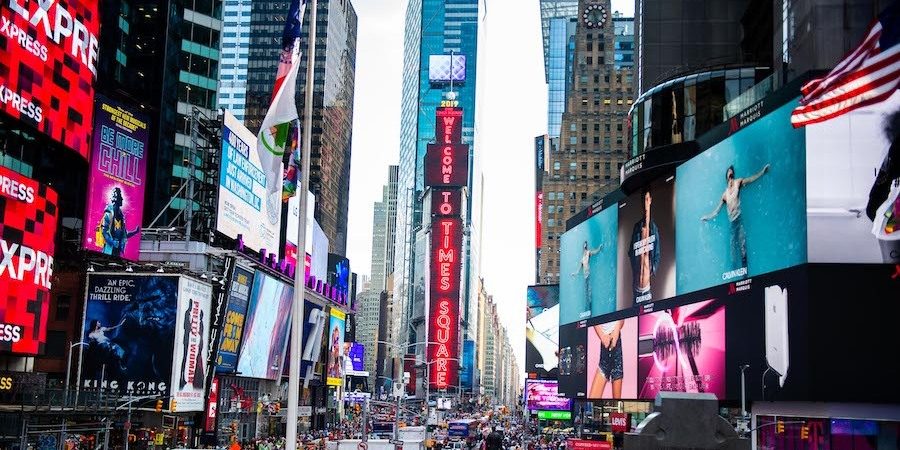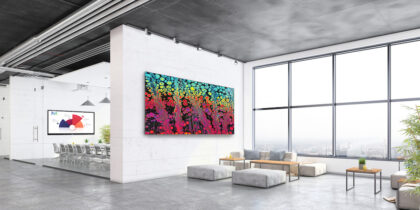You know it as the building where the ball drops on New Year’s Eve. But One Times Square is turning heads for a new reason lately. That’s because Jamestown, the real estate investment and management company that owns the iconic property, recently installed a massive, high-end LED display on the front of the building. Stretching an unprecedented 20 stories, the new display transforms the legendary facade into a groundbreaking visual experience.
At 11,639 square feet, the monumental display is powered by Samsung’s SMART LED Signage XPS Series. Five separate screens come together in a reinforced design that delivers uninterrupted color-uniform content in any setting. From complete takeovers and live-streaming, to full-motion video and interactive capabilities, the creative advertising and communication possibilities of the display are nearly limitless.
How did it all come to be? And what does it mean for the future of digital signage? Let’s dive into the story behind this game-changing visual innovation.
Challenging the status quo
From the outset, the team at One Times Square wanted to push the boundaries of what was possible with digital displays. “We want to challenge advertisers to raise the bar within the medium of digital and vinyl advertising,” says Michael Phillips, President of Jamestown. “[The goal is to] create interactive content that makes people pause, watch and engage.”
To bring that vision to life, One Times Square needed to find a partner that they could count on to deliver a quality result, and that had a proven track record for doing similarly high-profile work. They turned to the company that had designed and installed the neighboring Two Times Square display: Prismview, a Samsung Company.
“The idea was to create an instant icon,” says Don Szczepaniak, CEO of Prismview. “In the past, each sign was its own distinct piece of content delivery. But the idea of giving the Square a single canvas like this is completely new. It’s what drew Prismview to the project.”
Multiple screens, one canvas
The new display stands 350 feet tall, and is made up of five separate screens, ranging 8mm to 6mm in pixel pitch. Each of the screens can display its own unique content. All six screens can also lock together to run one image: a marvel of engineering and technology.
Your ultimate video wall guide
Learn how to build the optimal video wall for your business. Download Now
“In a standard ad, you’re looking at one screen that runs a prerecorded video,” says Ilidio Vincente, Prismview’s director sales for Eastern U.S. and Canada. “Now we can have live feeds, live broadcasting [of] what’s happening in the Square, picking up different events. It becomes a [sort of] television.”
Importantly, the quality of the image remains consistent. “We tie it all together, and all the different pixel pitches, and maintain the same image quality, even when you jump to 50 percent less diodes,” he says.
This requires substantially more processing speed than the average digital display, and Prismview is equipped to provide it. “Most boards run at about 5,000MHz processing speed,” says Vincente. “Our product runs at 50,000MHz. It’s the only one like it. When you run live feeds, you want that high refresh rate. That’s a major part of driving one seamless experience.”
Against all odds, a flawless execution
Pulling off a project like this isn’t easy. “One Times Square is one of the most visible, recognizable locations in the world,” says Phillips. “Installing a 200-foot-tall sign 350 feet in the air in the middle of Times Square had its challenges.”
Small freight elevators meant that the sign needed to be built one painstaking piece at a time. “Each module needed to be pulled up from a gantry [with] a set of wires just like a window washer would use,” says Vincente. “We had guys in the installation crew on a flatbed watching from below as each piece is yanked up 5, 10, 20 stories. It’s disconcerting!”
Ultimately, Prismview handled each challenge as it arose, up until the very end. “The design of our cabinets allows us to make changes on the fly,” says Vincente. “Literally a day before the installation began, we made one last modification to the upper board. We’re here to cater and meet the customer’s expectations. And we’ll meet them right up until the last minute.”
The birth of an instant icon
All in all, the sign creates a new type of theater in the heart of Times Square, which sees a daily count of over 350,000 pedestrians. “It’s the next generation of screens going into New York, and the first of its kind in Times Square,” says Vincente.
That was exactly the vision Jamestown had at the outset. “This new interactive technology allows advertisers to rent signs by the hour, minute or second, providing added value and flexibility,” says Phillips.
How do they know it’s working? No one can look away. “Everybody turns to look at the sign. Instantly, they’re drawn to it,” says Szczepaniak. “That feels significant. We’re happy and privileged to be a part of delivering this vision. Every time I see it, it makes me smile.”
Get your free guide to future-proofing your digital signage investment with the right LED display.









